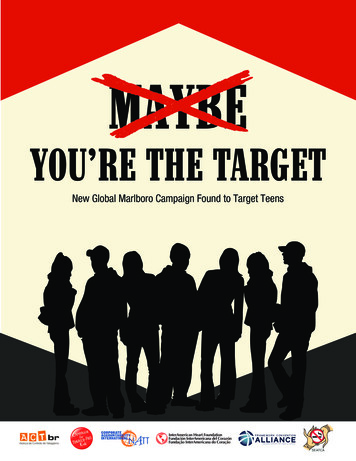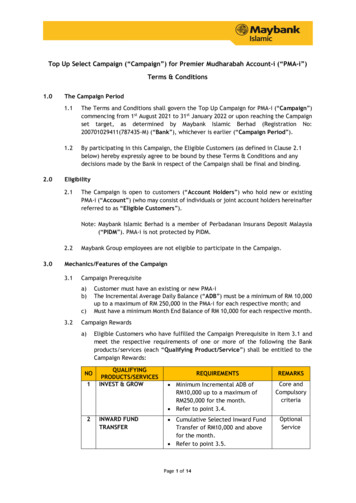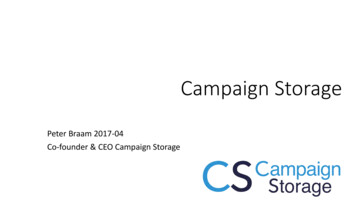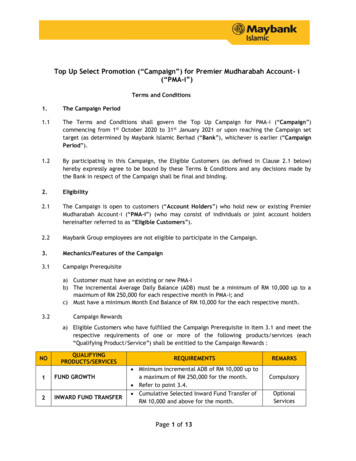
Transcription
MAYBEYOU’RE THE TARGETNew Global Marlboro Campaign Found to Target TeensFRAMEWORK CONVENTIONALLIANCEBUILDING SUPPORT FOR TOBACCO CONTROL
MAYBEYOU’RE THETARGETNEW GLOBAL CAMPAIGNFOUND TO TARGETTEENSContentsExecutive Summary, 1Introduction, 3Recruiting Replacement Smokers— Philip Morris’ history oftargeting youth, 5‘Don’t Be a Maybe.Be Marlboro.’ — A globalmarketing campaign found totarget teens, 7Don’t Be Marlboro —Country Court Rulings andChallenges, 17Conclusion and Call to Action, 20References, 21AcknowledgmentsA special thank you to Alianca deControle do Tabagismo (ACT)Brazil, HealthJustice Philippines,OxyRomandie, Tobacco ControlResearch Group at the Universityof Bath (www.tobaccotactics.org)and WhyQuit.com for providingcontent and photos for this report.iiTeenager smoking underneath “Be Marlboro” billboard, Philippines 2014. Source: Campaign forTobacco-Free Kids.
ExecutiveSummaryTobacco kills nearly 6 million peopleworldwide every year.1 To maintainprofits, tobacco companies mustreplace customers who quit or diefrom tobacco-related diseases withnew smokers.2 Replacement smokersare often youth who are attracted totobacco products through expensivemarketing campaigns that use imagesthat are highly appealing to youngpeople around the globe.3While tobacco companies claimpublicly that they do not market toyouth or design marketing campaignsthat target them, a 2013 studyconducted in low- and middle-incomecountries showed that 22 percent offive- and six-year-olds surveyed wereable to correctly identify Marlborocigarettes, the world’s best-sellingcigarette brand.4 Recognition ofglobal cigarette brands by youth is nota coincidence. Volumes of internalindustry documents and decades ofpeer-reviewed research show thattobacco companies target children asyoung as 13 years of age and suchmarketing increases youth smokingrates.5, 6Arguably, no tobacco product’smarketing has been more effectivein reaching youth than the marketingfor Marlboro cigarettes. Historically,Marlboro has been marketed usingthe iconic Marlboro Man and imagesof the rugged American West. Whilethe Marlboro Man has been retired inmany markets, the effort to appeal toyouth continues.In 2012, Philip Morris International(PMI), the maker of Marlboro and theworld’s largest publicly traded tobaccocompany, spent US 6.97 billion onmarketing its products and relatedexpenses.7 At least US 62 millionGerman Advertisement 2012. Source: deWilde Investor Day presentation.13of PMI’s 2012 marketing budget wasspent on launching new brands androlling out “Be Marlboro,” a globalmarketing campaign to replace theinfamous Marlboro Man.8Using concepts and imageryconsistent with the recommendationsof findings from previous Philip Morrisinternal research on marketing toteens,9, 10 the “Be Marlboro” campaigndraws on youth-oriented images andthemes that suggest to young peoplethat they should BE a Marlborosmoker.Launched in Germany in 2011, “BeMarlboro” has spread to more than 50countries.11 Although PMI claims that“Be Marlboro” targets only legal-agesmokers,12 campaign advertisementsfrom around the world clearly appealto minors by featuring young, hipdreamers and doers partying, falling inlove, adventure traveling and generallybeing “cool.” In fact, in October of2013, a German court banned “BeMarlboro” advertisements on thegrounds that the campaign is designedto encourage children as young as 14years of age to smoke, which is inviolation of Germany’s advertisinglaw.14 Although PMI has indicated itwill challenge the ruling,15 the banon the “Be Marlboro” advertisingcampaign will remain in place whilethe case is being litigated.16In spite of the German court’sfinding that “Be Marlboro”advertisements target youngteenagers and are in conflict withPMI’s own seemingly ineffectivecode of conduct,17 PMI continuesto aggressively rollout the “BeMarlboro” campaign internationally,including in low- and middleincome countries struggling with theenormous tobacco epidemic. Thesecountries include Brazil, where PMI is placing“Be Marlboro” posters at the pointof sale (POS), taking advantageof the lack of regulation andinspection to enforce the existingPOS advertising ban.1
German Advertisement 2012. Source: deWilde Investor Day presentation.18 Indonesia, where tobaccoadvertising laws are weak andwhere PMI posts massive “BeMarlboro” billboards on the street. Philippines, where tobaccocompanies continually attemptto thwart strong tobacco controlpolicies through the courts.This report documents the globalscope of Marlboro’s multimilliondollar rebranding campaign and howit threatens the health of millionsof youth around the world. It alsodocuments how “Be Marlboro”appeals to teens without regardfor advertising restrictions aimedat protecting youth in countriesincluding Brazil, Colombia, Germanyand Switzerland. The report furtheremphasizes the ineffectiveness ofvoluntary marketing codes and partialtobacco advertising, promotion andsponsorship bans at curbing thetobacco industry’s ability to marketto youth.In light of the evidence presented,this report calls on PMI toimmediately end all “Be Marlboro”marketing activities worldwide andpublish a detailed accounting of “BeMarlboro” activities by country on itscorporate website so that governmentsand public health organizations canassess the damage caused by thecampaign.All governments shouldcomprehensively ban all forms oftobacco advertising, promotion andsponsorship in accordance with theinternational tobacco control treaty,the World Health OrganizationFramework Convention on TobaccoControl (FCTC). Only comprehensivebans can prevent PMI and othertobacco companies from initiatingsimilar youth marketing activities inthe future.Young girl under “Be Marlboro” billboard,Indonesia 2014. Source: Campaign forTobacco-Free Kids.2
IntroductionGlobally, tobacco use is the leadingcause of preventable death.19 Tobaccokills nearly 6 million people annuallyand, if current trends continue,tobacco will kill more than 8 millionpeople worldwide by 2030.20 Themajority of smokers start smokingbefore the age of 18 and almost one infour smokers begins smoking beforethe age of 10.21 Every day, 80,000 to100,000 children around the worldbecome addicted to tobacco.22Tobacco companies have argued fordecades that their marketing efforts donot target youth, while simultaneouslyacting to prevent strong tobaccomarketing bans that protect youngpeople. Some companies, includingPhilip Morris International (PMI),have even gone so far as to promisein ineffective codes of conduct thatthey will not market tobacco productsto minors.23, 24 However, volumes ofpreviously secret internal industryArchetype Project Table of Contents.Philip Morris’s Archetype Projectlays out how to market cigarettes toteenagers. Source: Legacy TobaccoDocuments Library, University ofCalifornia, San Francisco.Outdoor Billboard, Germany 2012. Source: WhyQuit.com.documents publicly released as aresult of U.S. litigation settlementsand decades of peer-reviewed researchshow that tobacco companies targetchildren as young as 13 years of ageand such marketing increases youthsmoking rates.25, 26In 2012, PMI spent US 6.97billion on marketing and relatedexpenses.27 At least US 62 millionof PMI’s 2012 marketing budgetwas spent on new brands and theroll out of “Be Marlboro,” a globalmarketing campaign promotingMarlboro cigarettes.28 Using conceptsand imagery consistent with therecommendations of previous PhilipMorris internal research on marketingto teens,29, 30 “Be Marlboro” exploitsadolescents’ search for identity bysuggesting that — in the face ofuncertainty — they should BE aMarlboro smoker. Although PMIclaims that “Be Marlboro” onlytargets legal-age smokers,31 campaignadvertisements from around theworld clearly focus on youth-orientedimages and themes that appealto teenagers and feature young,attractive models partying, fallingin love, adventure traveling andgenerally being “cool.”In October 2013, a Germancourt banned “Be Marlboro”advertisements, finding that thecampaign encouraged teens asyoung as 14 years of age to smoke inviolation of Germany’s advertisinglaws.32 Although PMI has indicatedit will challenge the ruling,33 the banon the “Be Marlboro” advertisingcampaign will remain in placewhile the case is being litigated.34 InBrazil, CONAR (national council ofadvertising self-regulation), a nongovernmental organization, foundthat a “Be Marlboro” poster featuringthe phrase “I will be independent”targeted a youth audience in violationof the Brazilian Advertising SelfRegulation Code.35 Additionally, apublic prosecutor in Brazil recently3
Invitation to “Be Marlboro” sponsored concert, Switzerland. Source: OxyRomandie.demanded PMI and Souza Cruz,a subsidiary of British AmericanTobacco (BAT), remove all pointof-sale (POS) ads, citing Brazil’sexisting federal law banning tobaccoadvertising. To date, “Be Marlboro”advertisements are still running inBrazil.In spite of these rulings findingthat “Be Marlboro” advertisementsare directly aimed at youth, PMIcontinues to aggressively rollout the “Be Marlboro” campaigninternationally, including in countriessuch as Indonesia and China thatsuffer from the world’s highest ratesof tobacco use.This report reviews how tobaccocompanies use marketing campaignsto attract young smokers to replacedying customers and boost companyprofits. It describes PMI’s “BeMarlboro” campaign and illustrateshow, consistent with the findingsof the German court,36 the globalcampaign effectively and strategicallytargets vulnerable teenagers. Thereport concludes by demanding that4PMI end all “Be Marlboro” campaignactivities and immediately publish afull list of “Be Marlboro” marketingactivities by country on its corporatewebsite so that governments andpublic health organizations canassess the damage caused by thecampaign. Recognizing that voluntaryregulations and partial advertising,promotion and sponsorship bansare ineffective, the report also callson governments to ban all forms oftobacco advertising, promotion andsponsorship in accordance with Article13 of the FCTC to prevent PMIand other tobacco companies frominitiating similar marketing activitiesin the future.37“[I]f the tobacco companiesreally stopped marketingto children, the tobaccocompanies would be out ofbusiness in 25 to 30 yearsbecause they will not haveenough customers to stay inbusiness.”Bennett LeBow, Presidentand CEO of Vector Tobacco,Inc.38
RecruitingReplacementSmokers —Philip Morris’history oftargeting youthUp to half of all lifetime smokersdie from tobacco-related diseases.39To maintain profits and ensure theireconomic future, tobacco companiesmust attract young smokers to replacesmokers that die from tobacco-relatedillnesses.40 Because teenagers areuniquely vulnerable to marketing, thetobacco industry has spent decadesand billions of dollars developingmarketing tactics that hook teens andaddict them for life.41, 42Internal tobacco industry documentsmade public through landmark U.S.litigation settlements43, 44 reveal thattobacco companies have historicallytargeted teenagers as young as 13years of age as a key market, studiedthe smoking habits of youth anddeveloped marketing campaignsaimed directly at them.45, 46As early as 1969, Philip Morrisunderstood that teenagers begin“smoking for psychosocial reasons.it signifies adulthood. [and a teenagersmokes] to enhance his image in theeyes of his peers.”47 A 1984 internalPhilip Morris document states thatpeople begin smoking because of1) “.peer pressure, 2) to rebel/assertindependence, 3) to appear grownup [and] 4) to experiment,” and that“products targeted to [the] youngerend of spectrum [are] most viable.”48A Snake Sheds its Skin: Still Selling DeathIn 2003, after more than a decade of planning, Philip Morris Companies— then the parent company of both Philip Morris USA and PhilipMorris International — changed its corporate name to Altria in aneffort to improve its negative corporate image and distance itself fromthe tobacco business.49 In 2006, a U.S. federal judge found that PhilipMorris and other cigarette manufacturers had violated civil racketeeringlaws by engaging in a decades-long fraud to deceive the Americanpublic about the health risks of smoking.50 Two years later, in 2008,Altria spun off PMI, in large part to protect PMI from U.S. regulationand litigation and to give PMI more “freedom to pursue sales growthin emerging markets.”51 Although PMI and Altria have been legallyseparate companies since 2008, PMI continues to be led by former Altriaemployees, including the former CEO of Altria Group.52A decade later, in 1994, Philip Morrisrecognized that the “[c]hoice of a‘starter’ brand [coincides with][y]outhful conformity/rebellion.”53One key study conducted byPhilip Morris in the 1990s examinedthe emotional reasons for whypeople smoke.54 Internally calledthe Archetype Project, the reportoutlined how an individual’s attitudeand impressions about smoking areformed at an early age (between fourand nine years of age in some studyparticipants). The study also describedsmoking as an activity that can belinked to adult initiation rituals, risktaking, bonding with peers and theneed for youth to feel like they belongto a group and can partake in an “adultactivity.” Among other things, thestudy recommended that, in orderto attract customers, Philip Morris’marketing department should stress: smoking is for adults only,therefore making it more attractiveto teenagers; smoking is for people who like totake risks, are not afraid of taboosand see life as an adventure inwhich they prove themselves; the popularity of the brand andthat choosing it will reinforcethe consumer’s identity andintegration into a group; and using images of an Americanidentity that is “growing, searchingand striving” and emphasize theritualistic elements of smoking(particularly fire and smoke).55Many of the elements outlined inthe Archetype Project are reflected inPMI’s “Be Marlboro” campaign.5
On April 14, 1994 the Chief Executive Officers of the seven major U.S.-based tobacco companies stated under oath that nicotine is not addictive.Other hearings and subsequent litigation revealed that tobacco companies buried internal research showing nicotine was addictive and that theyknew cigarettes caused cancer, heart disease and other serious diseases.BIG TOBACCO: A PACK OF LIESIn 2006, a U.S. Federal District Court found that several major tobacco companies — including Altria, PMI’sparent company at the time of the 2006 ruling56 — coordinated efforts in a scheme to defraud the public aboutthe health effects of their products and that they were likely to continue to defraud the public into the future.57The presiding judge stated that: “Defendants’ marketing activities are intended to bring new, young, and hopefully long-lived smokers intothe market in order to replace those who die (largely from tobacco-caused illnesses) or quit.”58 “Defendants knew that youth were highly susceptible to marketing and advertising appeals, wouldunderestimate the health risks and effects of smoking, would overestimate their ability to stop smoking ”59 “Defendants used their knowledge of young people to create highly sophisticated and appealing marketingcampaigns targeted to lure them into starting smoking and later becoming nicotine addicts.”60In her testimony in this case, a former Philip Morris marketing executive acknowledged that, “Philip Morrisknows that cigarettes are one of the things that adolescents use in their transition from childhood toadulthood.”616
‘Don’t Bea Maybe.Be Marlboro’A global marketingcampaign found totarget teens62Switzerland print ad, 2012. Source: OxyRomandie.PMI is the largest publicly tradedcigarette company in the world.The company operates in more than180 countries and reported 8.6billion in profits in 2013.63, 64 PMI’sMarlboro cigarette is the world’shighest-selling cigarette brandand a key driver of the company’sglobal strategy to increase profits.65, 66According to Forbes Magazine,Marlboro is the 29th most valuableglobal brand and is the only tobaccoproduct on the list of the 100 mostvaluable brands.67 Marlboro’s globalgrowth is due in large part to PMI’saggressive marketing, including theMarlboro Man marketing campaignthat for decades used the iconiccowboy and western imagery toconvey independence, rebellion andan American life-style.68 Globally,the Marlboro brand is highlyrecognizable among youth. In a2013 study conducted among fiveand six-year-olds in Brazil, China,India, Nigeria, Pakistan and Russia,22 percent of the children in thestudy were able to correctly identifyMarlboro as a cigarette brand,including 43 percent of Chineseyouth.69In 2011, PMI launched “BeMarlboro” in an effort to revampMarlboro’s image among “youngadult smokers” and replace theinfamous Marlboro Man. 70 The “BeMarlboro” campaign was developedby Leo Burnett, PMI’s longtimeadvertising agency tasked with beingthe “guardians of Marlboro” andthe agency responsible for creatingthe Marlboro Man.71, 72 In an onlinevideo describing the development ofthe “Be Marlboro” campaign, LeoBurnett explains that to young people,“Freedom and adventure means onething: a profound desire to find apurpose in life. Unfortunately.thedaunting forces of society leave youngadult smokers paralyzed with inaction.They have little outside guidance inwhich to help them move forward inlife. They are frozen hiding behinda world of maybes Thus the ideawas born Marlboro doesn’t believein Maybes or sitting on the fencewatching from the sidelines.”73Mirroring concepts andrecommendations from the PhilipMorris Archetype Project conductedin the 1990s concerning the use ofsmoking by teenagers to transitionfrom childhood to adulthood, the“Be Marlboro” campaign seizeson adolescents’ search for identityby suggesting that, in the faceof uncertainty, they should BE aMarlboro smoker. Growing, searching,striving, risk taking, bonding withpeers, partaking in adult activities andseeking adventure to prove oneself, allelements recognized decades ago byPhilip Morris through its ArchetypeBE GLOBALInitially launched in Germanyin 2011, PMI’s recent reportsto investors indicate “BeMarlboro” has run in morethan 50 countries.74 To date,“Be Marlboro” marketing andpromotion materials have beendiscovered in Argentina, Brazil,China, Colombia, Germany,Georgia, Latvia, Indonesia,Israel, Japan, the Philippines,Qatar, Russia, Saudi Arabia,Switzerland, Ukraine and theUnited Kingdom.Project as appealing to vulnerableteens, play a central role in “BeMarlboro” marketing activities. Thecampaign’s promotional materialsfrequently feature young, attractivedreamers and doers partying, fallingin love, conquering heights, adventuretraveling, playing music and generallybeing “cool.”To promote “Be Marlboro” PMI hasused a wide range of tactics aroundthe world.7
BE MARLBORO ONBILLBOARDS(Outdoor Advertising)While outdoor advertising oftobacco products has beenbanned in many countries,including Canada, Brazil,Thailand and much of Europeto prevent youth exposure totobacco advertising, the practiceis still allowed in a numberof countries. For example, inGermany, Indonesia and thePhilippines, “Be Marlboro”images and slogans have beenprominently displayed in areasaccessible to teenagers andyouth, including bus stops,billboards and outside retailshops.Outdoor Billboard, Jakarta, Indonesia 2013. Source: Campaign for Tobacco-Free Kids.Young Adult SmokersMarketing Code WordsIn the late 1970s, the tobaccoindustry internally began usingthe term “young adult smoker”Outdoor Billboard, Germany 2012. Source: www.whyquit.com.to replace the words “youth”and “young smoker” in anattempt to dodge claims thatcompanies were targeting youth.Despite the shift in language,tobacco companies continuedto study the smoking behaviorof teenagers under the age of18 and promote cigarettes toyouth.75Outdoor POS Billboard, Philippines 2013. Source: http://statigr.am/p/506328660312626264 25740548.8
POS display by candy, Brazil 2014. Source: Johns Hopkins School of Public Health & ACT Brazil.Outdoor Billboard, Jakarta, Indonesia 2013. Source: Campaign for Tobacco-Free Kids.9
BE MARLBORO INCONVENIENCE STORES(Point-of-Sale Advertising)Tobacco products andadvertisements are often placedin shops at eye level and nearcandy where children andadolescents are likely to seethem. POS tobacco advertisingincreases the likelihood thatteenagers will begin smoking.76“Be Marlboro” POS advertisingis present in many of thecountries where the campaignis running, including Brazil, thePhilippines and Indonesia.Don’t be a Maybe” POS display at 7-Eleven, Philippines 2013. Source: HealthJustice Philippines.Young girl exposed to “Be Marlboro” point-ofsale advertisement. Brazil, 2014. Source: ACTBrazil.10“Maybe It’s time to explore” POS poster, Indonesia 2013. Source: Campaign for Tobacco-FreeKids.
BE MARLBORO INSHOPPING MALLS(Interactive booths)PMI interacts directly withsmokers “not only at the pointof sale but also where theirinterests bring them.”77 In2012, PMI set up interactivepromotional booths at shoppingmalls across Ukraine. Thebooths featured large cigarettepack displays and promotionalvideos on monitors in areasaccessible to youth andteenagers. After buying cigarettepacks, customers registered toplay interactive games on iPadsand win various prizes.78PMI video of “Be Marlboro” promotional booth at public shopping mall in Ukraine featuring ateam of young brand promoters recruiting young smokers, playing a Marlboro video game andgiving away Marlboro clothing giveaways.7911
BE MARLBORO SPONSORSMUSIC EVENTS(Concert sponsorships)Tobacco companies have long reachedteenagers by sponsoring concertsfeaturing popular artists or DJsand by placing cigarette brands onpromotional materials.80, 81 To promote“Be Marlboro” PMI has sponsoredconcerts in Switzerland, Germany,Russia and South America. In Switzerland, PMI sponsored‘Marlboro Beat’ lounges atinternational music festivals attendedby young people from around theworld.82 In Russia, events associated witha “No More Maybe” tour featuredBritish dance music artists such asJoel Edwards and Faithless.83 In Stuttgart, Germany, popular DJsplayed at a ‘No Maybes Allowed’event — a secret brand launch eventto which 600 people were invited.84 The “Be Marlboro” summertour in South America featured aperformance by the popular DJ,David Guetta.85Marlboro Beat flyer for summer festival seriesin Switzerland. Source: OxyRomandie.12Marlboro Beat lounge at Paleo music festival, Switzerland.Source: OxyRomandie.Promotional Video of South America summer tour.86
BE MARLBORO USESBEACH EVENTS(Brand Ambassadors)In Tunisia, “Be Marlboro” usedyoung, attractive spokespersonsto go to the beach to interactdirectly with young people.Using electronic tablets tocollect consumer information,people were asked to declarethemselves a “yes,” “no”or “maybe.” If “yes” wasselected, they were challengedto compete for “Don’t be aMaybe” branded t-shirts andhats.87 In Latin America, the“Be Marlboro” summer beachtour invited young people onthe beach into the “M Spot”to try different extreme sports,interact with brand promotionalstaff, collect passes for freedrinks and attend concerts andparties. The beach events appearto be “invitation only,” butthe only thing separating theattendees from the rest of thebeach population, including anyteenagers that may have beenpresent, was a rope.88PMI video from promotional activities at popular summer break locations in Tunisia features anattractive team of brand promoters recruiting young smokers, giving away Marlboro clothing andorganizing party games.89PMI video from “Be Marlboro” promotional tour of popular summer break beaches on the AtlanticCoast of Latin America features parties on public beaches, Marlboro models, promotional giveawaysand a concert by DJ David Guetta.9013
BE MARLBORO SPONSORSBREAKDANCE PARTIES(Commercials andPromotional Videos)Perhaps the marketing that mostdirectly appeals to teenagersare the numerous commercialsand promotional videos thathave been developed for the“Be Marlboro” campaign. Thesevideos are widely availableonline for anyone to see. Manyof the images and slogansthat appear elsewhere in thecampaign are repeated in thevideos but they are amplifiedby clips of young and attractivepeople partying, breakdancing,kissing, going on adventuresand being rebellious. The videosalso feature music by Madonna,Nicki Minaj, David Guettaand other popular artists. Onesuch video from Saudi Arabiafeatures young partiers at ahip-hop party called “ExpressYourself” and asks attendeesto profess their love forMarlboro cigarettes.91 Anothervideo called “Maybe Stories”personalizes the ‘Don’t Be aMaybe’ message by telling thestories of young people whostop saying “maybe.”92Promotional video of party inRyhad, Saudi Arabia featuringDJs, break dancing, and videogame booths. The end of the videofeatures a “behind the scenes”segment in which an interviewerasks young Saudis to name theirfavorite cigarette.9314
BE MARLBOROON THE WEB(Social Media Marketing)Internet and social networkingsites are rapidly becoming avehicle for tobacco companiesto advertise and promote theirproducts.94 Searching YouTubealone for ‘Don’t Be a Maybe’generates videos produced forthe campaign and videos of “BeMarlboro” events. Additionally,Marlboro brand websites,such as a site in Ukraine, aresupposedly for adults only,but the age requirements forentering the sites do not requireverification.95Social media screen grab, China 2013.YouTube produced Search 184,000 videos. Accessed January 24, 2014.Ukraine brand website- weak age verification.15
BE MARLBOROBRANDSTRETCHINGTobacco companies placetobacco brand names, logosor visual brand identities onnon-tobacco products, suchas clothing or accessories, topromote their products andcircumvent traditional tobaccomarketing bans. PMI hasaggressively promoted the “BeMarlboro” campaign sloganson cigarette lighters, t-shirts,hats and cars in China, thePhilippines, Tunisia, Ukraineand other countries.“Be Marlboro” branded t-shirt, Ukraine.96‘Don’t Be a Maybe’ lighters, Philippines andChina. Source: Health Justice/ ThinkTank.16“Be Marlboro” branded Mini Coopers, Philippines. Source: Source: http://statigr.am/p/504279599074370030 47519983.
Don’t Be Marlboro —Court Rulings andLegal ChallengesIn the face of mounting evidencethat PMI’s “Be Marlboro” campaigntargets teenagers, public healthadvocates and consumers have filedcomplaints against the campaign inGermany, Switzerland, Brazil andColombia.Germany. In response to the “BeMarlboro” campaign, tobacco controlorganizations in Germany called onthe German Minister for ConsumerProtection to take action againstthe campaign. After officials inMunich launched an investigation,PMI voluntarily agreed to removesome outdoor billboards and cinemaadvertisements in August 2012,although the company denied anywrongdoing.97 PMI, however,continued to run “Be Marlboro”advertisements at the point of saleand in other locations using slightlyaltered imagery and slogans. InOctober 2013, a German courtbanned the marketing campaign,finding that it illegally encouragedteenagers and young adults betweenthe ages of 14 and 21 to smoke.98 Inits decision, the court stated “theadvertising specifically targets risktaking, rebellious youths”99 and foundthat PMI’s argument that the purposeof “Be Marlboro” advertising is toencourage adult smokers to switchto Marlboro cigarettes was notcredible based on the fact that “thereis already a high degree of brandloyalty in this group of persons.”100Shortly after the ruling, PMI indicatedit would challenge the decision101and asked the court to allow the “BeMarlboro” campaign to continuewhile the case was being litigated.102The court denied PMI’s request,stating that “the public interest inthe protection of youths and healthoutweighs the economic interests of[PMI] in continuing the campaign.”103Therefore, the ban on the “BeMarlboro” advertising campaign willremain in place while the case is beinglitigated.104Germany bans MarlboroMaybe, cigarette adsAuthorities banned a controversialadvertising campaign byAmericantobacco giantMarlboro inGermanyon Wednesday, claiming itwas too focused on getting young people to startsmoking.17
Don’t Be Marlboro —Court Rulings andLegal Challenges (cont.)Colombia: In January 2014,Corporate AccountabilityInternational mobilizedadvocates to file consumercomplaints calling on theColombian Superintendent ofIndustry and Commerce to issuea restraining order banningPMI and its advertising agency,Leo Burnett, from conducting“Be Marlboro” promotionaland advertising activities inthe country. The complaintsalso call on the Superintendentto investigate and sanctionthe companies for violatingColombia’s tobacco advertisingban. To date, the Colombiangovernment has not respondedto the complaints.Online commercial from Colombia featuresyoung attractive models and slogans like“Fuck Maybe,” “Maybe never wrote a song,”“Maybe never changed the world” and“Maybe isn’t in our dictionary.10518
Don’t Be Marlboro —Court Rulings andLegal Challenges (cont.)Switzerland: After “BeMarlboro” was launched inSwitzerland in May 2012,the Swiss tobacco controlorganization OxyRomandiefiled three separate complaintsrelated to the campaign withthe self-regulatory body of theSwiss advertising industry, theSwiss Commission for Fairnessin Commercial Communication.OxyRomandie’s complaintsto the commission assert that“Be Marlboro” advertisingand marketing events violatethe commission’s advertisingcode and urge the commissionto enforce the code against itsmember company PMI.106 Todate, the industry-sponsoredoversight commission has yet torespond to the complaints.Brazil: Consumers from the cityof São Paulo filed a complaintwith CONAR (nationalcouncil of advertising selfregulation), a non-governmentalorganization with which PMIand other tobacco companiesare affiliated, arguing that a “BeMarlboro” poster v
marketing tactics that hook teens and addict them for life.41, 42 Internal tobacco industry documents made public through landmark U.S. litigation settlements43, 44 reveal that tobacco companies have historically targeted teenagers as young as 13 years of age as a key market, studied the smoking habits of youth and developed marketing campaigns










